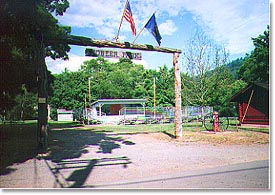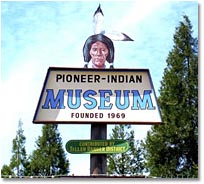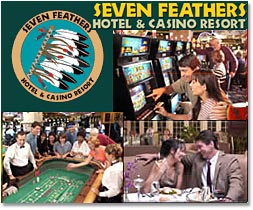| CANYONVILLE
OREGON PROFILE |
|

Canyonville, an historic community of Oregon, is
situated at the north end of Canyon Creek Canyon, where
this defile opens into the valley of the South Umpqua,
about six miles east of Riddle. Hudson's Bay Company
trappers used this route to California in 1828. (Oregon
Geographic Names 1992)
The first known non-indians to
visit the site of present day Canyonville was Alexander
Roderick McCloud in 1828. He was on his way from Fort
Vancouver to California to hunt and trap. The second
known group of travelers was headed by Ewing Young in
1837. His party drove 600 cattle from California to
Oregon's Willamette Valley. The Reverend Jason Lee
visited the Umpqua in 1838 and again in 1840.
In 1846, Jesse and Lindsey Applegate left Fort Hall on a
trip south to search for a new route to Oregon from the
East. In his diary Lindsey wrote they spent the night of
June 24, 1846, camping at the entrance to "historic
Umpqua Canyon," now Canyonville. It took the brothers a
full day to travel up the small stream and cross over
the summit near Azalea. They re-explored the trail the
next day.
 The
trail they blazed became a road as both north and south
bound travelers increased in numbers. Wagon trains
sometimes required two and three weeks to travel the 11
miles from Azalea to Canyonville. The Canyon was a rough
passage. In many places the immigrants had to take their
wagons apart and move them downstream by hand. The
trail they blazed became a road as both north and south
bound travelers increased in numbers. Wagon trains
sometimes required two and three weeks to travel the 11
miles from Azalea to Canyonville. The Canyon was a rough
passage. In many places the immigrants had to take their
wagons apart and move them downstream by hand.
The
little settlement at the north end of the passage was a
welcome sight to many a weary traveler. Both the Canyon
and the flat at the north end were sometimes littered
with abandoned equipment.
The first recorded passage
of wagons through the Umpqua Canyon was in 1843, when
Stephen Meek, a brother of the noted mountain man,
Joseph Meek, guided the Lansford W. Wastings party of
emigrants from the Willamette Valley to California.
Another small group of wagons came north from California
in the same year, passing through the canyon on their
way to the Willamette Valley.
Meek followed the old
trail used by the Hudson's Bay Company fur brigades.
This route had also been used by the detachment of the
Wilkes' US Exploring Expedition, commanded by Lt. George
F. Emmons en route from Oregon to California in 1841.
In 1846 the canyon route was used by the wagon train led
over the "Southern Route," the Scott-Applegate Trail.
This party, led by Cpt. Levi Scott, consisted of about
150 persons and 42 wagons. Their stock was so exhausted
from desert travel that they suffered greatly in coming
down the canyon. The oxen were so weak that much of the
party's equipment was abandoned. The family of Rev. J.
A. Cornwall was in the 1846 immigration; unable to
proceed further, Cornwall stopped on a small stream
which enters Calapooia Creek near present day Oakland.
Here he built a crude cabin, and the family wintered
there, obtaining a few supplies from the Hudson's Bay
Company post, Fort Umpqua. The Cornwall dwelling gave
the creek its present name, Cabin Creek. A relief party
from the settlements in the Willamette helped some of
the hapless members of the 1846 train to reach the
Willamette Valley just as winter closed in.
In 1851
Joseph Knott and Joel Perkins operated a ferry across
the South Umpqua calling the settlement Kenyonville.
Knott built the first store, a small log cabin with a
dirt floor. His stock consisted of the staple
merchandise available, overalls and tobacco--and
whiskey. Later on he sold his store to Jackson Reynolds
and Joseph Roberts. Roberts had taken a Donation Land
Claim of 160 acres north of the settlement. The two
partners later sold the store to Jesse Roberts, brother
of Joseph. It was Jesse who, in 1856, built the Roberts
Hotel and the grist mill. In 1858 he platted the town
site and named it Canyonville. Jesse Roberts died at the
age of 47 and is buried along side his wife, Mary Jane,
in the old Canyonville Cemetery on the hill overlooking
the town he founded.
When gold-bearing
quartz was found nearby, a rush began, and in 1852,
Congress appropriated $120,000 to build a military road
from California to Oregon. The road through the canyon,
however, was not completed until 1858. It was built
under the supervision of General Joseph "Fighting Joe"
Hooker of Civil War fame.
The Hooker Survey became
the overland road used by freighters and the
California-Oregon Stage Company, organized in 1860, and
by other north-south bound travelers until 1920. This
became the main road to California until the arrival of
the railroad.
The strikes brought an influx of miners
and settlers to Southern Oregon, anxious to share in the
gold bonanza. By 1852 pack trains were making regular
trips from Scottsburg at the head of tidewater on the
Lower Umpqua to the mines in Southern Oregon.
Canyonville became an important way station. Rough
Canyon Passage made rest stops mandatory. Supplying
miners, packers, and early immigrants became good
business.
In the early days Canyonville was
known as North Canyonville. The post office was
established July 6, 1852, with John T. Boyle first
postmaster of this early pioneer office. The name was
originally applied in contradistinction to South
Canyonville, a community located a few miles to the
south. The latter never obtained a post office, and
eventually the two communities merged. Canyonville post
office is located on Canyon Creek about a mile from its
junction with South Umpqua River, and about six miles
east of Riddle. Thomas Wilson served as first postmaster
of this office which is still in operation. (Oregon Post
Offices 1842-1982, pp. 21, 72)
Canyon Creek is
erroneously supposed by many to be Cow Creek although it
does traverse that stream through a wide valley east of
Glendale. The pass at the head of Canyon Creek is 2,015
feet in elevation. Canyonville has an elevation of 747
feet. Those who have visited this part of the state will
realize that Canyon Creek and Canyonville are
appropriate names.
The canyon was known in pioneer
days as Umpqua Canyon. The railroad finally selected
ascended Cow Creek from Riddle and joined the old stage
road not far from Glendale. The stage route for many
years continued up Canyon Creek and today travelers over
I-5 may see where there have been earlier routes through
the canyon. The total descent from the pass at the head
of Canyon Creek to Canyonville is nearly 1,300 feet,
most of which occurs in the south part of the canyon.
Difficulties have continued here in modern times, for on
January 16, 1974 nine men working in a Pacific Northwest
Bell Company relay station about a mile south of
Canyonville were killed when a massive earth slide swept
away the building.
 In
1992, the Cow Creek Band of Umpqua Tribe of Indians
opened the Cow Creek Bingo Hall. Today, Seven Feathers
is a full Nevada-style casino with over 1,000 Slot
machines, 21 Table Games, live Poker, Keno and Bingo. A
2003 addition, the non-smoking casino area has 3 table
games and over 100 slots. Seven Feathers features 50,000
square feet of gaming space in Southern Oregon’s largest
facility of its kind. More than 1 million guests visit
Seven Feathers Hotel & Casino Resort annually. In
1992, the Cow Creek Band of Umpqua Tribe of Indians
opened the Cow Creek Bingo Hall. Today, Seven Feathers
is a full Nevada-style casino with over 1,000 Slot
machines, 21 Table Games, live Poker, Keno and Bingo. A
2003 addition, the non-smoking casino area has 3 table
games and over 100 slots. Seven Feathers features 50,000
square feet of gaming space in Southern Oregon’s largest
facility of its kind. More than 1 million guests visit
Seven Feathers Hotel & Casino Resort annually.
Seven Feathers Hotel amenities include 146 deluxe
guestrooms, indoor heated pool, two spas, sauna, fitness
center and locker rooms. Other hotel features include
full concierge service, continental breakfast,
complimentary morning newspaper, and free access to
fitness and recreation facilities, cable television,
Pay-per-View movies, in-room hair dryer, coffee service,
and complimentary valet parking as well as turn down and
room service. Other services include adjoining rooms,
rollaway beds and cribs, at no charge. Shop the Gift
Gallery while visiting.
Seven Feathers also
offers a 22,000 sq. foot convention center with the
capability of eight smaller rooms to cater any size
event from business meeting to professional boxing.
Posh elegance of the Camas Room, the family dining
in the Cow Creek Restaurant is second to none or enjoy
soup, sandwich and your favorite ice cream in Scoops Ice
Cream Parlor. Whatever your decision is concerning
dining, we are sure you’ll be satisfied. Relax in the
Cabaret Lounge or try our Stix Sports Bar with eleven
televisions, several beers on tap and a fantastic menu
to help watching your favorite sporting even more
memorable.
Seven Feathers is known for
bringing great entertainment to the area from country,
oldies, rock & roll, specialty concerts and comedy
shows. Also sporting events such as boxing, rodeo,
bodybuilding and pool tournaments. Check the events page
for current and upcoming listings.
If you’re a
snow-bird, spend the night in our beautiful RV park or
if you’re just here for a brief visit, try our day-use
lot.
Pioneer-Indian Museum is located Just West
of I-5, Exit 98, Fifth St. This museum offers a glimpse
to the area's historical past.
Canyonville has
much more to offer so visit this historic town soon.
For
Business, Lodging, Real Estate & Recreation In This
Town/City, Please Use Menu Above.
|
|